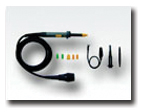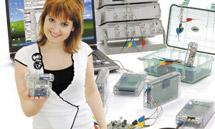|
|
ADS-2102 Digital Storage Oscilloscope
ADS-2102 Digital Storage Oscilloscope
|
|
Digital storage oscilloscope. Dual channels + external trigger; Bandwidth: 100MHz; Max. Sample rate: 1GSa/s (500MSa/s each channel); Max. Memory Depth: 40Kpts for single channel (20Kpts double channel); Waveform math: +, -, ×, Inverted; Trigger types: Edge, Video, Pulse, Slope, Alternate; 32 types Automatic measurement; 7” 480x234 64K color TFT LCD display; USB device, USB host, RS-232, Pass/Fail; Power Supply 110-220V; Dimensions (WxHxD): 15.7x4.3x5.8in/399x110.5x148.5mm; Weight: 5.3lb/2.4kg.
Manuals:
|
|
AKTAKOM ADS-2102 digital storage oscilloscope: 2 channels; 100MHz; Real Sample rate 1GSa/s (500MSa each ch.), Equivalent 50Gsa/s; Max. Memory Depth: 40Kpts (20Kpts double channel); 7” Widescreen color TFT. High functionality of ADS-2102 benchtop digital oscilloscope allows a wide range of tasks such as production process as well as design and maintenance.
Features
- Unique 7” wide-screen Color TFT LCD display
- 40Kpts Max Memory depth
- Abundant trigger function
- 32 parameters Auto measure function
- Max recording length: 6Mpts
- The longest single recording time: 33.3h
- User interface in 12 languages
- 6-digit Hardware Frequency Counter
- Support Pass/Fail function
- PictBridge Function
- Powerful Easyscope Software for PC
- Interfase USB 2.0 Host FAT32 & USB 2.0 Device, RS-232
- Power Supply 110-220V
General Specifications:
- Channels: Dual channels + external trigger
- Analog Bandwidth: 100MHz
- Real-time Sample rate: Max. 1GSa/s (500MSa/s each channel)
- Equivalent Sample rate: 50GSa/s
- Max Memory Depth: 40Kpts for single channel (20Kpts double channel)
- Acquisition: Normal, Average (4…256), Peak Detect (10ns)
- Input coupling: DC, AC, GND
- Max. input voltage: 400Vpk (DC+AC, 1MΩ)
- Input impedance: 1MΩ±2%||17pF±3pF
- Interpolation: Sin(x)/x, Linear
- Horizontal Scale (s/div): 2,5ns/div~50s/div
- Rise time: ≤3.5ns
- Vertical sensitivity: 2mV/div~10V/div (at BNC input)
- Vertical Resolution: 8 bit
- DC Gain Accuracy: ±4% (2mV/div), ±3% (5mV/div~5V/div)
- Waveform math: +, -, ×, Inverted
- FFT: 4 windows (Rectangle, Hanning, Hamming, Blackman). Sampling points: 1024
- Automatic measurement (32 types): Vpp, Vmax, Vmin, Vamp, Vtop, Vbase, Vavg, Mean, Crms, Vrms, ROVShoot, FOVShoot, RPREShoot, FPREShoot, Rise time, Fall time, Freq, Period, +Wid, -Wid, +Dut, -Dut, Bwid, Phase, FRR, FRF, FFR, FFF, LRR, LRF, LFR, LFF
- Cursor measurement: Manual mode, Track mode and Auto mode
- Save/Recall: Support 2 Group referenced Waveforms, 20 Group setups, 20 Group captured Waveforms internal Storage/Recall function and USB flash driver storage function
- Trigger mode: Auto, Normal, Single
- Trigger type: Edge, Pulse, Video, Slope , Alternate
- Trigger sources: CH1, CH2, EXT, EXT/5, AC Line
- Trigger Coupling: AC, DC, LFrej, HFrej
- Trigger Level Range: CH1, CH2: ±6 divisions from center of screen EXT: ±1.2V, EXT/5: ±6V
- Recorder: 6 M
- Waveform Record: Max 1500 frames
- Interface: USB device, USB host, RS-232
- Display Type: 7” color TFT LCD, 480×234 pixels, 64K colors
- Wave display range: 8x18div
- Power Supply: 100-240VAC, CAT II; 45Hz to 440Hz; 50VA Max
- Dimension: 15.7x4.3x5.8in/399x110.5x148.5mm
- Weight: 5.3lb/2.4kg
Specifications:
Input:
|
Input Coupling
|
AC, DC, GND
|
|
Input Impedance
|
1MΩ±2% || 17pF±3pF
|
|
Maximum input voltage
|
400V (DC+AC PK-PK, 1MΩ input impedance), CAT I, CAT II
|
|
Probe attenuator
|
1X, 10X
|
|
Probe attenuator Factors Set
|
1X, 10X, 100X, 1000X
|
Horizontal System:
|
Real Time Sampling Rate
|
4Kpts memory depth Series:
Single Channel: 500MSa/s, Double Channel: 250MSa/s (When time base faster than 250ns/div)
32K/40K/2Mpts memory depth Series:
Single Channel: 1GSa/s, Double Channel: 500MSa/s (When time base faster than 50ns/div)
5Kpts/CH memory depth Series: 1GSa/CH
18K/24Kpts memory depth Series: 2GSa/CH
|
|
Equivalent Sampling Rate
|
50GSa/s (40MHz bandwidth: 25GSa/s; 25MHz bandwidth: 10GSa/s)
|
|
Measure Display Modes
|
MAIN, WINDOW, WINDOW ZOOM, SCAN, X-Y
|
|
Time base Accuracy Horizontal Scan Range
|
±100ppm measured over 1 ms interval
|
|
1/2.5/5/10/25ns/div - 50s/div (According to the Bandwidth)
|
|
SCAN: 100ms/div - 50s/div (1-2.5-5 sequence)
|
Vertical System:
|
Vertical Sensitivity
|
4K/15K/118K/124Kpts memory depth Series:
2mV/div - 5V/div (1-2-5 order)
32K/140K/2Mpts memory depth Series:
2mV/div - 10V/div (1-2-5 order)
|
|
Channel Voltage Offset Range
|
4K/5K/18K/24Kpts memory depth Series: 2mV-100mV: ±2V
102mV-5V: ±40V
|
32K/40K/2Mpts memory depth Series: 2mV-200mV: ±1.6V
206mV-10V: ±40V
|
|
Vertical Resolution
|
8 bit
|
|
Channels
|
2
|
|
Analog Bandwidth
|
100MHz
|
|
Single-shot Bandwidth
|
100MHz
|
|
Lower frequency limit (AC-3dB)
|
≤10Hz (at input BNC)
|
|
DC Gain Accuracy
|
≤±3.0%: 5mV/div to 10mV/div in Fixed Gain Ranges
|
|
≤±4.0%: typical for 2mV/div and Variable Gain Ranges
|
|
DC Measurement Accuracy: All Gain settings ≤100mV/div
|
± [3%X(|reading|+|offset|)+1% of |offset|+0.2div+2mV]
|
|
Rise time
|
<3.5ns
|
|
Vertical input coupling
|
AC, DC, GND
|
|
Math operation
|
(+),( -), (*), (/), FFT
|
|
FFT
|
Window mode: Hanning, Hamming, Blackman, Rectangular
|
|
Sampling points: 1024
|
|
Digital storage oscilloscope
|
20MHz±40% Typical (Note: 25MHz bandwidth oscilloscope don't have this function, BW limited below 20MHz±40% when using probe X1)
|
Measure System:
|
Automatic measurement (32 Types)
|
Vpp, Vmax, Vmin, Vamp, Vtop, Vbase, Vavg, Mean, Crms, Vrms, ROVShoot, FOVShoot, RPREShoot, FPREShoot, Rise time, Fall time Freq, Period, +Wid, -Wid, +ut, -Dut, Bwid, Phase, FRR, FRF, FFR, FFF, LRR, LRF, LFR, LFF
|
|
Cursor Measure
|
Manual mode, Track mode and Auto mode
|
Trigger System:
|
Trigger Types
|
Edge, Pulse, Video, Slope , Alternative
|
|
Trigger Source
|
CH1, CH2, EXT, EXT/5, AC Line
|
|
Trigger Modes
|
Auto, Normal, Single
|
|
Trigger Coupling
|
AC, DC, LF rej, HF rej
|
|
Trigger Level Range
|
CH1, CH2, CH3, CH4: 6divisions from center of screen
|
|
EXT: 1.2V
|
|
EXT/5: 6V
|
|
Trigger Displacement
|
Pre-trigger: (Memory depth / (2*sampling))
|
|
Delay Trigger: 260div
|
|
Holdoff range
|
100ns~1.5s
|
|
Edge Trigger
|
Edge type: Rising, Falling, Rising and Falling
|
|
Pulse Width Trigger
|
Trigger Modes: ( > , <, = ) Positive Pulse Width, ( >, <, = ) Negative Pulse Width
|
|
Pulse Width Range: 20ns 10s
|
|
Video Trigger
|
Support signal Formats: PAL/SECAM, NTSC
|
|
Trigger condition: odd field, even field, all lines, line Num
|
|
Slope Trigger
|
( > , <, =) Positive slope, ( > , <, =) Negative slope
|
|
time: 20ns-10s
|
|
Alternative Trigger
|
CH1, CH2, CH3, CH4 trigger type:
|
Edge, Pulse, Video, Slope
|
Hard Ware Frequency Counter:
|
Reading resolution
|
6 bytes
|
|
Range
|
DC Couple, 10Hz to Max Bandwidth
|
|
Signal Types
|
Satisfying all Trigger signals (Except Pulse width trigger and Video Trigger)
|
X-Y Mode:
|
X-pole Input
|
Channel 1 (CH1) / Channel 2 (Ch2) or
|
|
Y-pole Input
|
Channel 1 (CH3) / Channel 2 (Ch4)
|
|
Phase Error
|
±3 degrees
|
|
Sample Frequency
|
XY mode has a breakthrough that trade oscilloscopes restrict sampling rate at 1MSa/s and 4Kpts memory depth Series supports 5kSa/s~200MSa/s
32K/40K/2Mpts memory depth Series: supports 25kSa/s~100MSa/s, 2GSa/s real-time series supports: 10kSa/s~1GSa/s
|
Control Panel Function:
|
Auto Set
|
Auto adjusting the vertical, Horizontal system and Trigger Position
|
|
Save/Recall
|
Support 2 / 4 Group referenced Waveforms, 20 Group setups, 20 Group captured Waveforms internal Storage/Recall function and USB flash driver storage function.
|
Acquisition System:
|
Sample Types
|
Real time, Equivalent time
|
|
Peak Detect
|
Captures glitches down to 1Ons wide regardless of sample rate
|
|
Sample Mode
|
Sample, Peak Measure, Average
|
|
Averages
|
4, 16, 32, 64, 128, 256
|
Generic Specification:
Display System:
|
Display Mode
|
Color TFT 7in. (178mm) diagonal Liquid Crystal Display
|
|
Display Mode
|
480 horizontal by 234 vertical pixels
|
|
Display Color
|
64K color
|
|
Display Contrast (Typical state)
|
150:1
|
|
Backlight Intensity (Typical state)
|
300nit
|
|
Wave display range
|
8x18div
|
|
Wave display mode
|
Point, Vector
|
|
Persist
|
Off, 1sec, 2sec, 5sec, Infinite
|
|
Menu Display
|
2sec, 5sec, 10sec, 20sec, Infinite
|
|
Screen-Saver
|
Off, 1min, 2min, 5min, 10min, 15min, 30min, 1hr, 2hr, 5hr
|
|
Skin
|
Classical, Modern, Tradition, Succinct
|
|
Waveform interpolation
|
Sin(x)/x, Linear
|
|
Color model
|
Normal, Invert
|
|
Languages
|
Simplified Chinese, Traditional Chinese, English, Arabic, French, German, Russian, Spanish, Portuguese, Japanese, Korean, Italian
|
Environments:
|
Temperature
|
Operating: 50°F to 104°F / 10°C to 40°C
|
|
Not operating: -4°F to 140°F / -20°C to 60°C
|
|
Cooling
|
The fan forces it cold.
|
|
Humidity
|
Operating: 85%RH 104°F/40°C, 24 hours
|
|
Not operating: 85%RH 149°F/65°C, 24 hours
|
|
Height
|
Operating: at 0 to 9843 feet/3000 meters; Not operating: after 50085 feet/15,266 meters
|
Power Supply:
|
Input Voltage
|
100-240VAC, CAT II, Auto selection
|
|
Frequency Scope
|
45Hz to 440Hz
|
|
Power
|
50VA Max
|
Mechanical:
|
Dimension
|
Length
|
12"/305mm
|
|
Width
|
5 ¼"/133mm
|
|
Height
|
6 1/8"/154mm
|
|
Weight
|
5.1lb/2.3kg
|
Accessories
Included:



- CD-ROM (including User Guide and Application Software)

Optional:



| ADS-2102 Digital Storage Oscilloscope - Control panel |
|
|
| ADS-2102 Digital Storage Oscilloscope - Rear view |
|
|
Analyze the signal detail
You have a noisy signal displayed on the oscilloscope and you need to know more about it. You suspect that the signal contains much more detail than you can now see in the display.
Looking at a Noisy Signal
The signal appears noisy and you suspect that noise is causing problems in your circuit. To analyze the noise better, follow these steps:
- Press the ACQUIRE button to see the acquire menu.
- Press the Acquisition option button or turn the Universal knob to select Peak Detect.
- If necessary, press the DISPLAY button to see Display menu. Turn the Universal knob to adjust waveform intensity and grid brightness to see the noise more clearly.
- Peak detect emphasizes noise spikes and glitches in your signal, specially when the time base is set to a slow setting.
Separating the Signal from Noise
To reduce random noise in the oscilloscope display, follow these steps:
- Press the ACQUIRE button to display the acquire menu.
- Press the Acquisition option button or turn the Universal knob to select Average.
- Press the Averages option button to see the effects of varying the number of running averages on the waveform display.
Averaging reduces random noise and makes it easier to see the details of a signal.
Analyzing a Differential Communication Signal
You are having intermittent problems with a serial data communication link, and you suspect poor signal quality. Set up the oscilloscope to show you a snapshot of the serial data stream so you can verify the signal levels and transition times.
Because this is a differential signal, you use the math function of the oscilloscope to view a better representation of the waveform.
To activate the differential signals connected to channel 1 and channel 2, follow these steps:
- Press the CH1 button and set the Probe option attenuation to 10X.
- Press the CH2 button and set the Probe option attenuation to 10X.
- Set the switches to 10X on the probes.
- Press the AUTO button.
- Press the MATH button to see the Math Menu.
- Press the Operation option button and select - .
- Press the CH1-CH2 option button to display a new waveform that is the difference between the displayed waveforms.
- You can adjust the vertical scale and position of the Math waveform.
To do so, follow these steps:
A. Remove the channel 1 and channel 2 waveforms from the display.
B. Turn the CH1 and CH2 VOLTS/DIV and VERTICAL POSITION knobs to adjust the vertical scale and position.
Note: First be sure to compensate both probes. Differences in probe compensation appear as errors in the differential signal.
Application of X-Y function
Viewing Impedance Changes in a Network
Connect the oscilloscope to monitor the input and output of the circuit. To view the input and output of the circuit in an X-Y display, follow these steps:
- Press the CH1 MENU button and set the Probe option attenuation to 10X.
- Press the CH2 MENU button and set the Probe option attenuation to 10X.
- Set the switch of the probe to 10X.
- Connect the channel 1 probe to the input of the network, and connect the channel 2 probe to the output.
- Press the AUTO button.
- Turn the Volts/div knobs to display approximately the same amplitude signals on each channel.
- Press the DISPLAY button.
- Press the Format option button and select XY.
The oscilloscope displays a Lissajous pattern representing the input and output characteristics of the circuit.
- Turn the VOLTS/DIV and VERTICAL POSITION knobs to optimize the display.
- Press the Persist option button and select Infinite.
- Press the Intensity or Brightness option buttons and turn the Universal” knob to adjust the contrast of the screen.
- Apply the Ellipse method to observe the phase difference between the two channels

Sin=A/B or C/D where =phase shift (in degrees) between the two signals from the formula above, you could get:=arcsine(A/B) or arcsine(C/D). If the main axis of the ellipse is at I and IV quadrant, must be in the range of (0~π/2) or (3π/2~2π). If the main axis is at II and III quadrant, must be in the range of (π/2~π) or (π~3π/2).
Catch the single signal
To capture a single event, you need to gather some pre-test knowledge of the signal in order to correctly set up the trigger level and slope. If you are not sure the instance of the signal, you can observe it through auto or normal trigger mode to ensure the trigger level and slope.
The following steps show you how to use the oscilloscope to capture a single event.
1. Set the Probe option attenuation to 10X and set the switch to 10X on the probe.
2. Trigger set up:
- Press “TRIG MENU” button to show the “Trigger Menu”
- Under this menu, set the trigger type to “edge”, Edge type is “Rising”, source is “CH1”, trigger mode is “Single”, coupling is “DC”
- Adjust the horizontal time base and vertical scale to the satisfied range
- Turn the “LEVEL” knob to adjust the trigger level
- Press the “RUN/STOP” button to start capturing
When the trigger conditions are satisfied, data appears on the display representing; the data points that the oscilloscope obtained with one acquisition and press the RUN/STOP button again rearms the trigger circuit and erases the display.
Taking Cursor Measurements
You can use the cursors to take time and voltage measurements of a waveform quickly.
Measuring Ring Frequency
To measure the ring frequency at the rising edge of a signal, follow these steps:
- Press the CURSORS button to see the Cursor Menu.
- Press the Mode button to select Manual.
- Press the Type option button and select Time.
- Press the Source option button and select CH1.
- Press the Cur A button and turn the universal knob to place the cursor A on one peak of the ring.
- Press the Cur B button and turn the universal knob to place the cursor B on the nearest peak of the ring.
You can see the delta time and frequency (the measured ring frequency) on the top left of the screen.

Measuring Ring Amplitude
To measure the amplitude, follow these steps:
- Press the CURSORS button to see the Cursor Menu.
- Press the Mode button to select Manual.
- Press the Type option button and select Voltage.
- Press the Source option button and select CH1.
- Press the Cur A option button and turn the universal knob to place the cursor A on the highest peak of the ring.
- Press the Cur B option button and turn the universal knob to place the cursor B on the lowest peak of the ring.
You can see the following measurements on the top of the left screen:
- The delta voltage (peak-to-peak voltage of the ringing)
- The voltage at Cursor A.
- The voltage at Cursor B.

Taking Simple Measurements
Observe a unknown signal in a circuit, display the signal quickly and measure the frequency and peak-to-peak amplitude.
1. Using Auto set
To quickly display a signal, follow these steps:
- Press the CH1 button, set the Probe option attenuation to 10X and set the switch to 10X on the probe.
- Connect the channel 1 probe to the signal.
- Press the AUTO button.
The oscilloscope sets vertical, horizontal, and trigger controls automatically. If you want to optimize the display of the waveform, you can adjust these controls manually till you are satisfied with the waveforms.
Note: The oscilloscope displays relevant automatic measurements in the waveform area of the screen based on the signal type detected.
2. Taking Automatic Measurements
The oscilloscope can take automatic measurements of most displayed signals. To measure signal frequency and peak-to-peak amplitude, follow these steps:
(1) Measure signal frequency
- Input the signal to channel 1.
- Press the AUTO button.
- Press the MEASURE button to see auto Measure Menu.
- Press the top option button.
- Press the Time option button to enter the Time Measure menu.
- Press the Source option button to select input signal channel.
- Press the Type option button to select Freq.
The corresponding icon and measure value will display on the third option area.
(2) Measure signal peak-to-peak amplitude
- Press the MEASURE button to display auto measure menu.
- Press the top second option button.
- Press the Voltage option button to enter the Voltage measure menu.
- Press the Source option button to select input signal channel.
- Press the Type option button to select Vpp.
The corresponding icon and measure value will display on the third option area.
Triggering on a Video Signal
Observe the video circuit in a piece of medical equipment and Use the video trigger to obtain a stable display.
Triggering on Video Field
To trigger on the video fields, follow these steps:
- Press the TRIGGER MENU button to see trigger menu
- Press the top option button and select Video.
- Press the source option button and select Ch1.
- Press the Sync option button and select Odd Field or Even Field.
- Press the Standard option button and select NTSC.
- Turn the horizontal S/Div knob to see a complete field across the screen.
- Turn the vertical Volts/Div knob to ensure that the entire video signal is visible on the screen.
Triggering on Video Lines
To trigger on the video lines, follow these steps:
- Press the TRIGGER MENU button to see the trigger menu
- Press the top option button and select Video.
- Press the Sync option button and select Line Num and turn the universal knob to set a specific line number.
- Press the Standard option button and select NTSC.
- Turn the S/Div knob to see a complete video line across the screen.
- Turn the Volts/Div knob to ensure that the entire video signal is visible on the screen.
Frequently Asked Questions
How to change from Chinese to English my ADS-2022 /2042 /2062 /2102 /2152?
After the Acquisition is set to "Averages" or Display Persistence is set ON, the waveform refreshes slowly
The measured voltage amplitude value is 10 times greater or smaller than the actual value
How to save data in a USB Flash Drive?
After the oscilloscope is powered on the display remains dark, what should I do?
The signal is displayed as ladder like waveform
There is wave form displayed, but it is not stable
When changing the horizontal sweep on the digital oscilloscope at different horizontal points observed inexplicable change in the form of the same signal, why is this happening?
| How to change from Chinese to English my ADS-2022 /2042 /2062 /2102 /2152? |
|

Please press the button DEFAULT SETUP to be sure your ADS-2022 Oscilloscope is at MENU first page. You shall see same chinese symbols as shows in a picture above.

Now press the button UTILITY to display the first menu page at the screen.

Finally press the button #1 and choose English or a different language by using knob #2.
Up
|
| After the Acquisition is set to "Averages" or Display Persistence is set ON, the waveform refreshes slowly |
It is normal in these settings.
Up
|
| The measured voltage amplitude value is 10 times greater or smaller than the actual value |
Check whether the channel attenuation coefficient and the attenuation coefficient of the probe used is match.
Up
|
| How to save data in a USB Flash Drive? |
|
This oscilloscope allows you to save data to an external USB Flash Drive only if the drive is formatted with FAT32.

If you haven't noticed one huge change with Windows 7 is that FAT32 is no longer an option on formatting drives. You are now left with the options of either NTFS or exFAT. OK so your asking what is exFAT? Well its not FAT32, acutally its compatible with FAT64.

So let's Format external USB Flash drive with FAT32 using DOS
First you need to find what your Hard Drive is named (the label) that is easy to do right click on the hard drive and it will show you in the top box. As you can see mine has no level in the picture bellow. You also need to note which drive letter it is. Mine is Drive: G.
Next thing you need to do is to find your command prompt

Once you get to command prompt you will need to type this:
format /FS:FAT32 G:
Note: You need to change the letter G to the letter of your drive

Then just answer the questions as you like for a volume label, etc. It will take time according to the driver size.

Now for more information of "How to Save and Recall a Waveform details" go to equipment User's Guide or find it by the following links:
- For the ADS-2061M go to PDF page 53 (49 if printed) and do not forget that a USB Flash Drive is an external memory. See User's Guide.
- For all other ADS models (2022, 2042M, 2061M, 2062 & M, 2102 & M, 2152 & M) go to PDF page 42 (74 if printed) See User's Guide.
Up
|
| After the oscilloscope is powered on the display remains dark, what should I do? |
|
Please implement the following fault treatment procedure.
- Check whether the power cable is connected properly.
- Ensure the power switch is turned on.
- Restart the instrument after completing the checks above.
- If the oscilloscope still can not work normally, please call for service.
Up
|
| The signal is displayed as ladder like waveform |
- The time base setting maybe is too slow. Turn the horizontal SCALE knob to increase horizontal resolution.
- Maybe the display Type is set to "Vectors". Set it to "Dots" mode.
Up
|
| There is wave form displayed, but it is not stable |
- Check whether the Source item in the TRIG MODE menu is in conformity with the signal channel used in the practical application.
- Check on the trigger Type item: The common signal chooses the Edge trigger mode for Type and the video signal the Video. Only if a proper trigger mode is applied, the wave form can be displayed steadily.
- Try to change the trigger coupling into the high frequency suppress and the low frequency suppress to smooth the high frequency or low frequency noise triggered by the interference.
Up
|
| When changing the horizontal sweep on the digital oscilloscope at different horizontal points observed inexplicable change in the form of the same signal, why is this happening? |
|
In fact, this is not a problem.
Just keep in mind that you're using a digital oscilloscope, which digitizes the signal with different sampling rates depending on the selected horizontal sweep, and then connects the digitized points with strait line while restoring the real shape of the signal.
Your first screen shows that you are measuring voltage 50 Hz with the 10 ms / div sweep and a sampling frequency of 20 kHz Ks/s
One signal period (20 ms), digitized in this mode, 20E-03 (sec) * 20E03 (1/sec) = 400 points. This is enough to properly restore and interpolate a sine wave of 50 Hz (i.e. in a period of 20 ms).
Normal display, with a sweep 10 ms / div:

Distortion of the same signal at 10 s / div sweep

Your second screen is set to sweep 10 sec / div, and sample rate on a sweep turned to 20 samples per second (20 Sa / s). I.e. one signal period 20 ms had: 20E-03 (sec) * 20 (1/sec) = 0.4 points. That means that to restore (to interpolate the points) a sine wave with less than one point in time is impossible, so you get this mess (known as "aliasing" or a false frequency) formed by the beats of the measured frequency and sampling frequency.

In order to correctly install a data collection in a digital oscilloscope one should follow a simple rule - the sampling rate must be at least 5-10 times higher than the frequency signal, in that case you will not have the issues that we just discussed.
This applies to all digital oscilloscopes and in no way connected to any particular make or model of oscilloscope or its probes.
Up
|
Performing automatic measurements with ADS-2xxx series oscilloscopes
Back to the section
|
|















